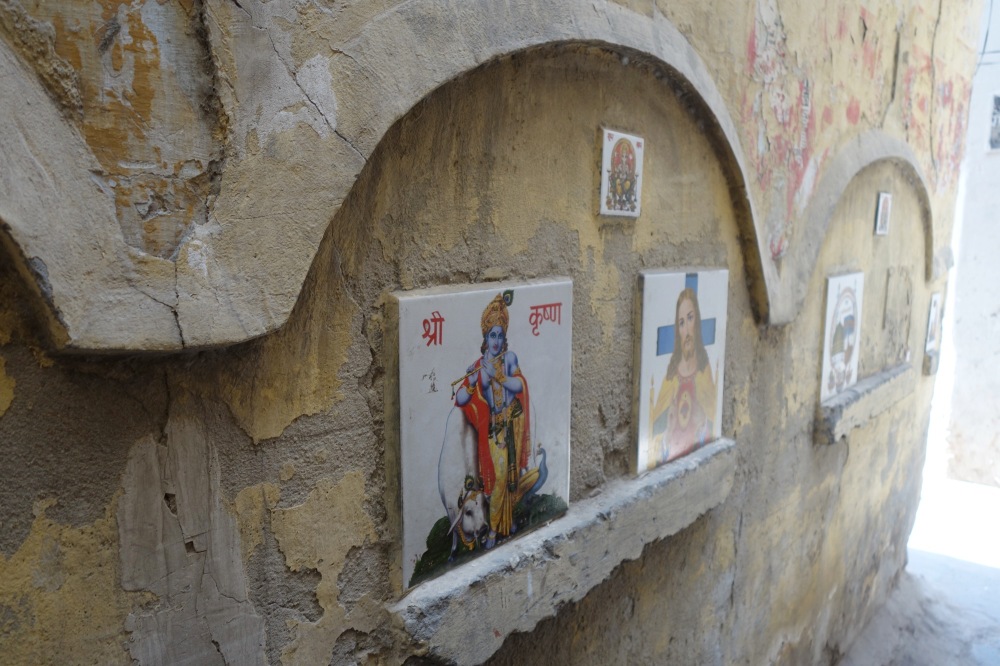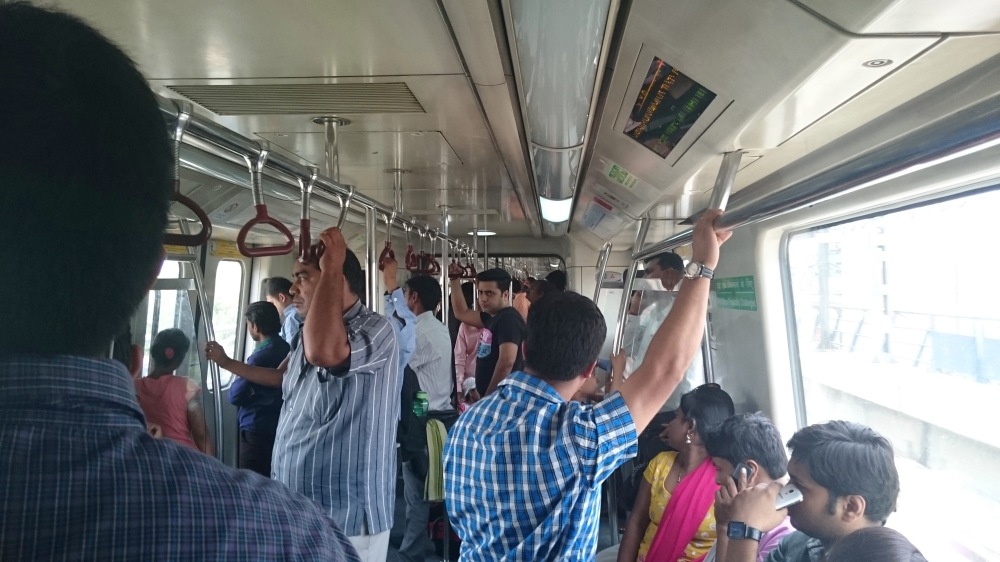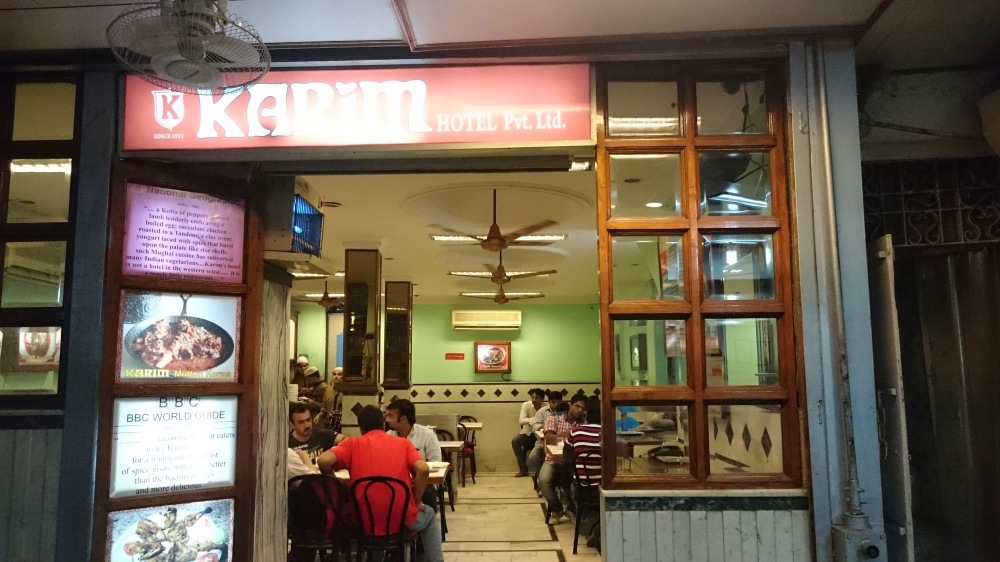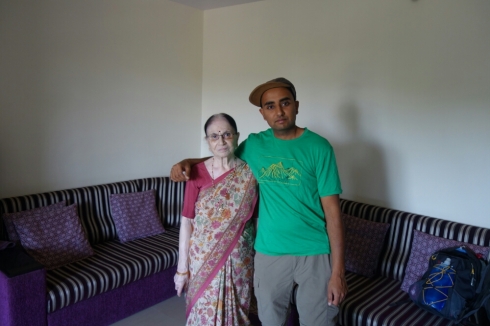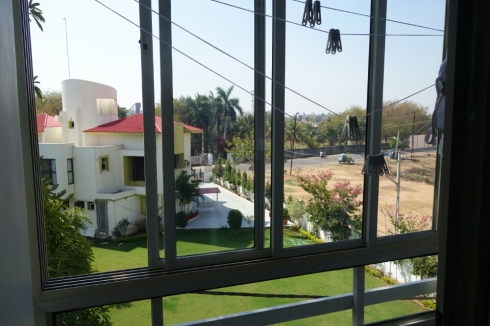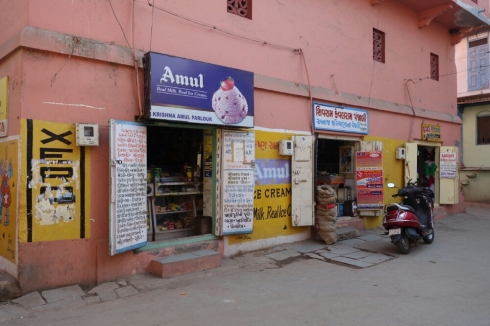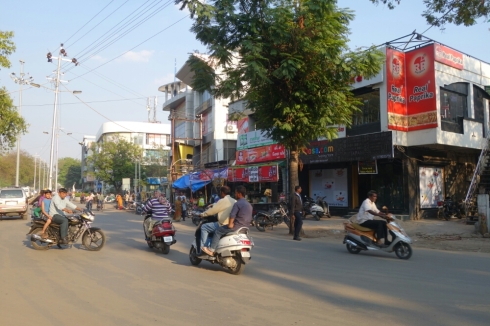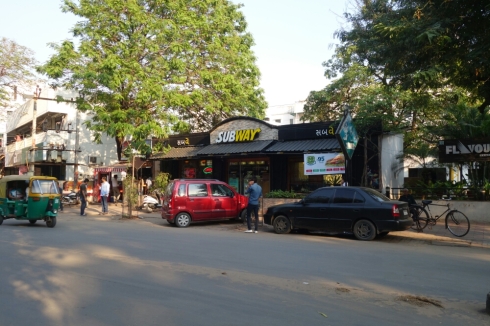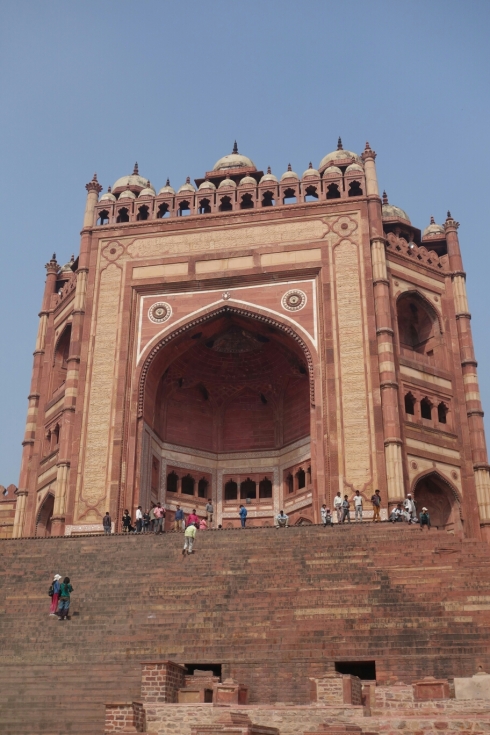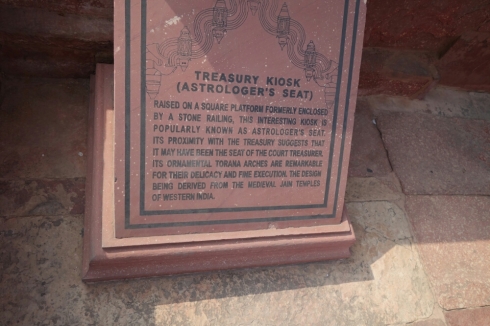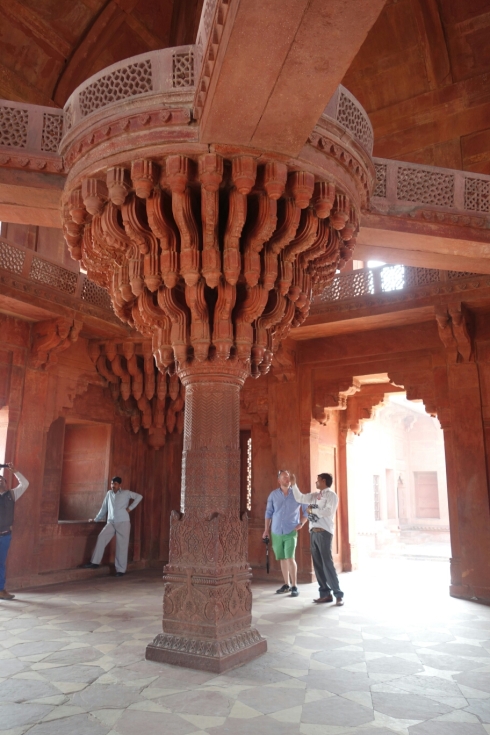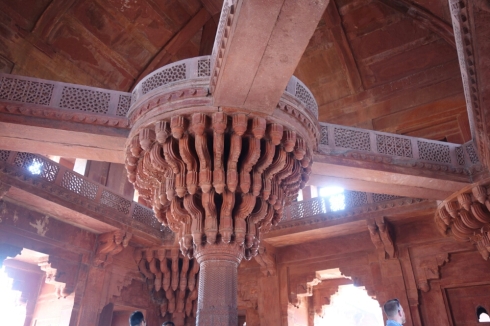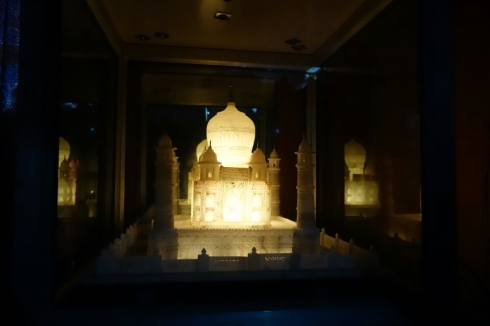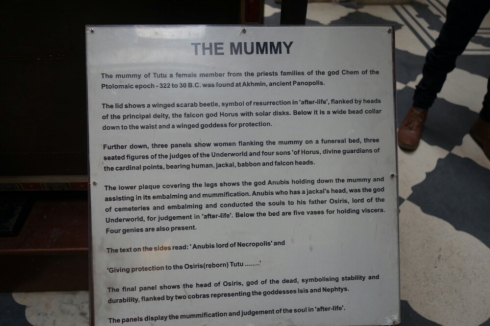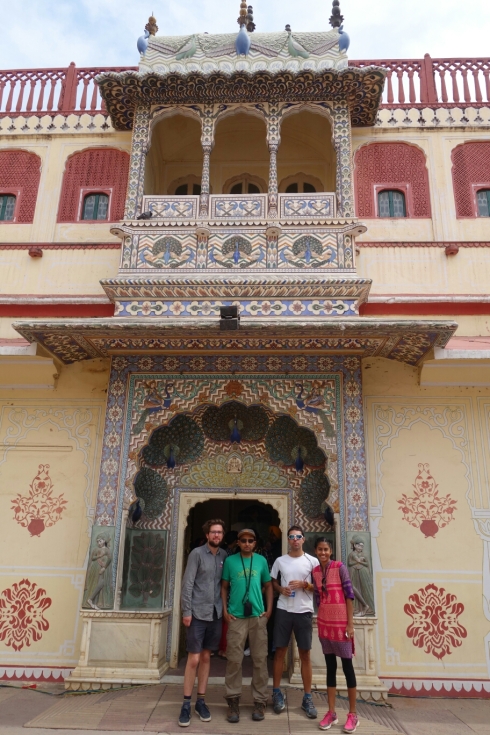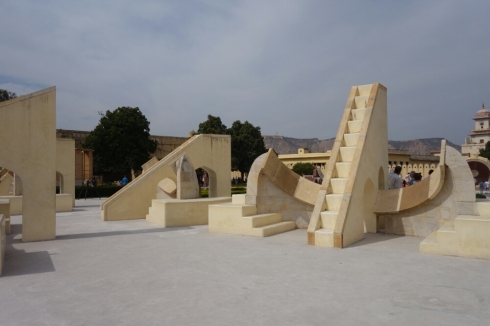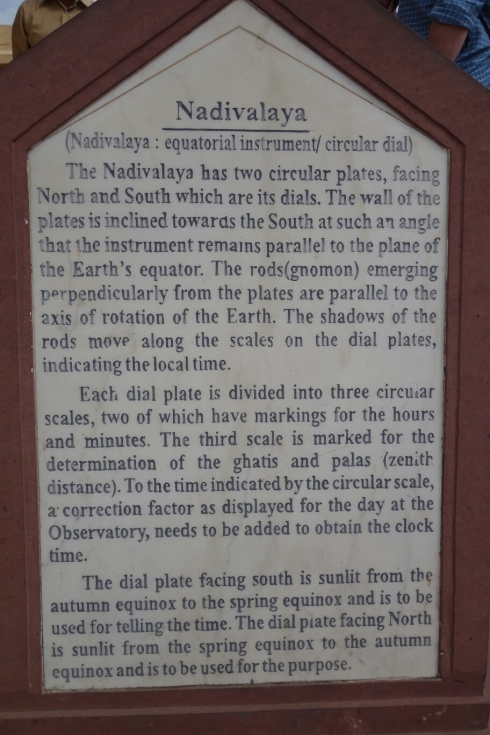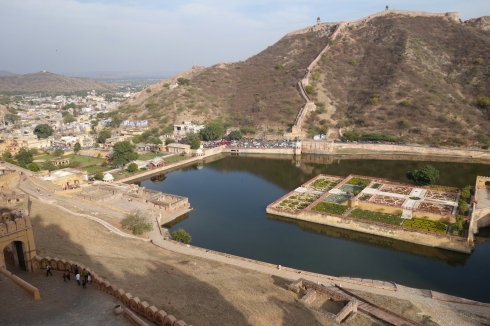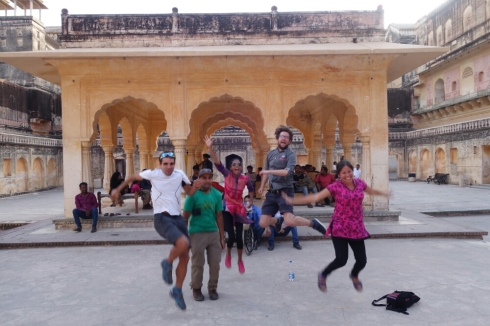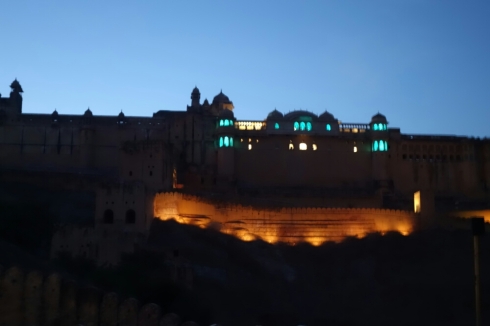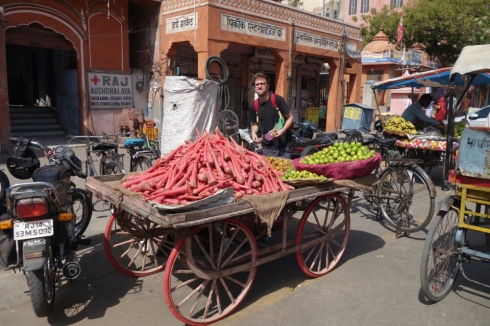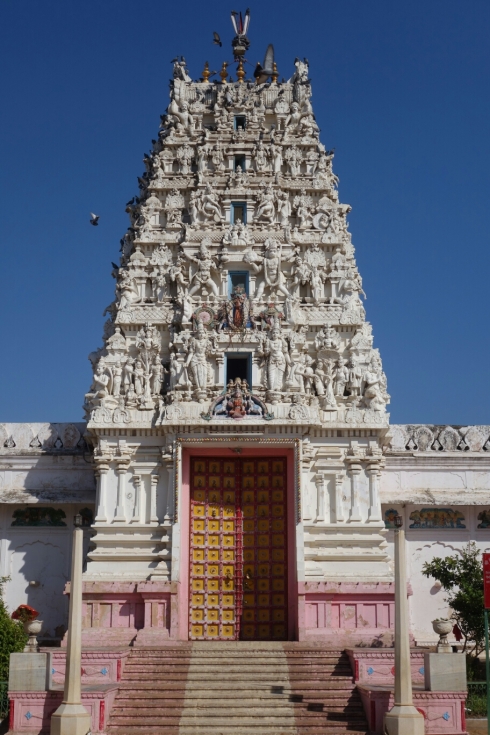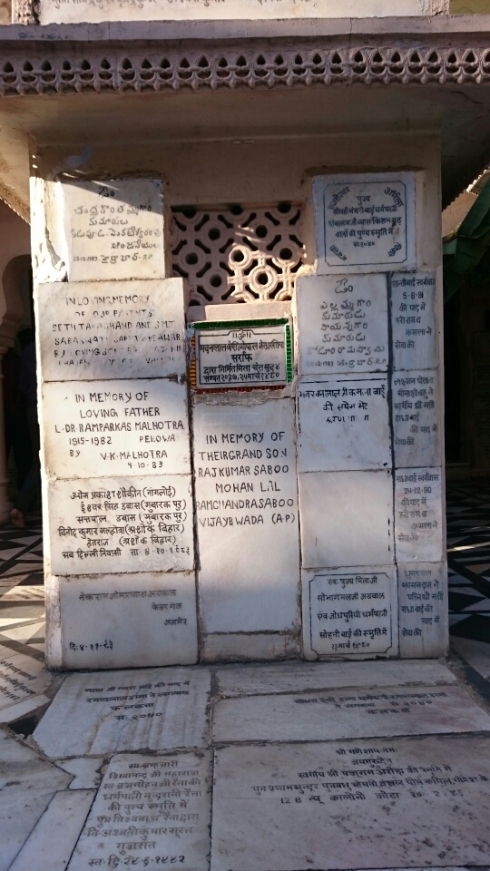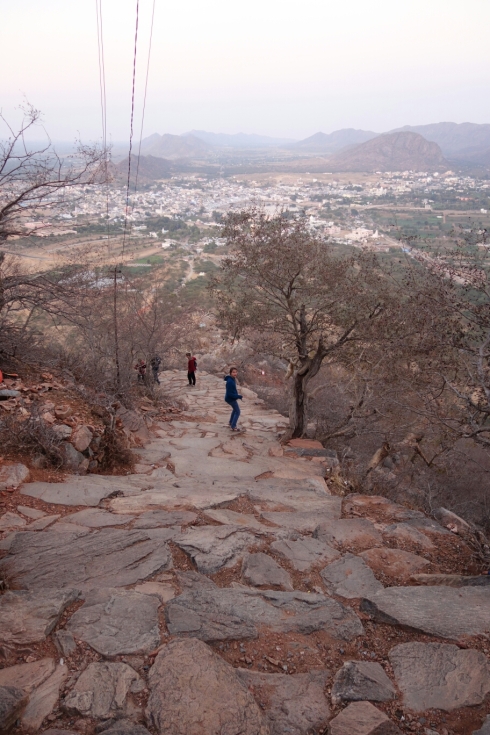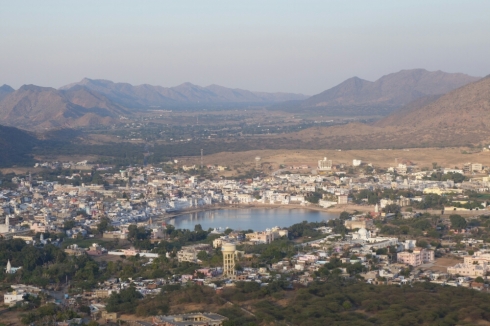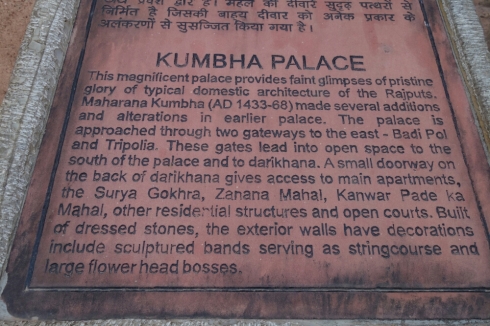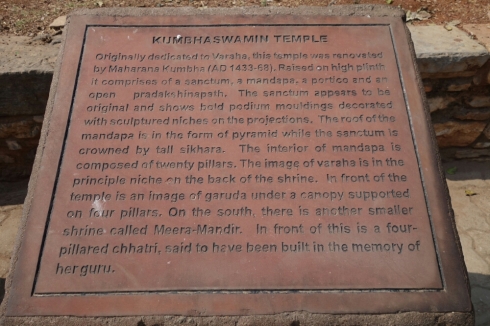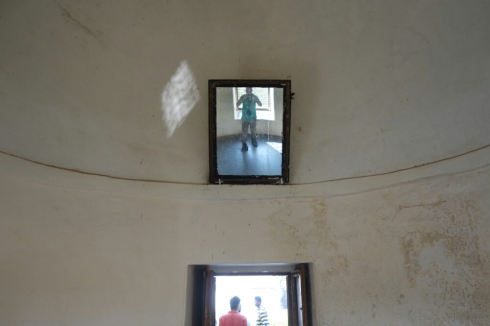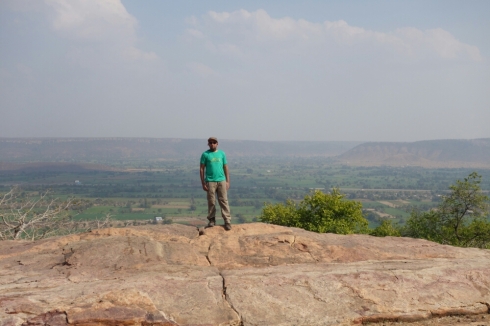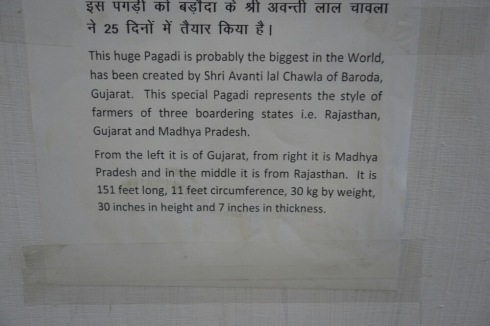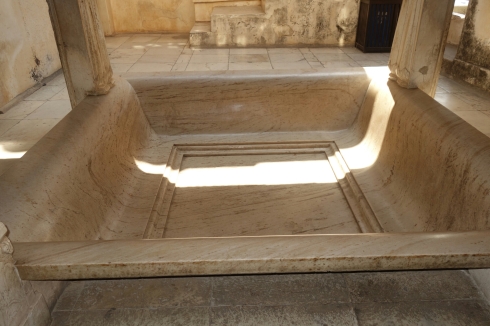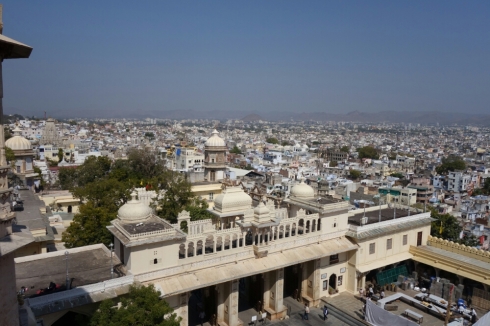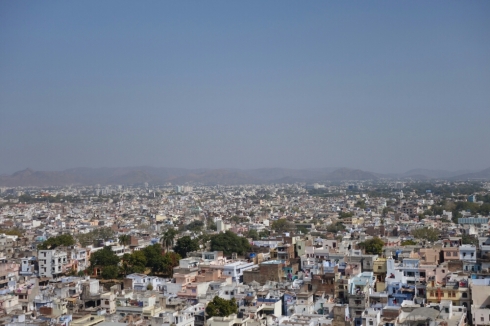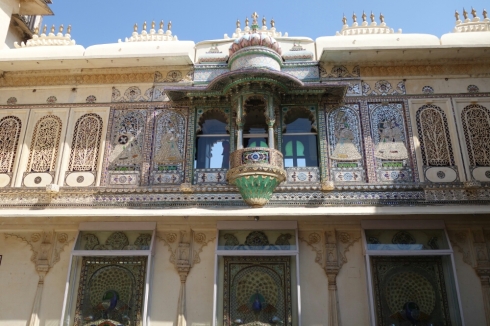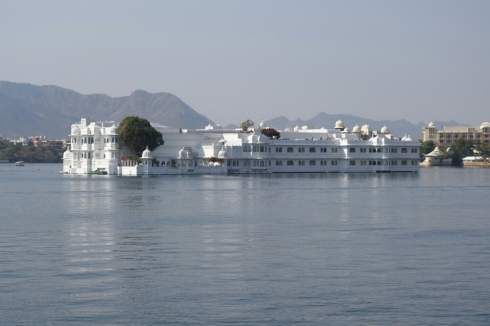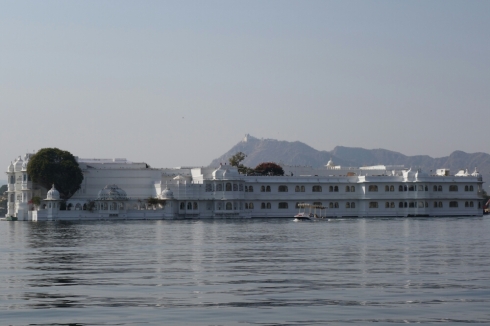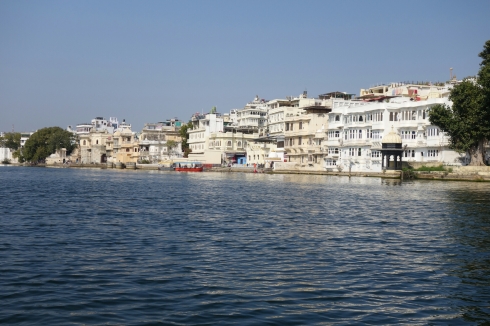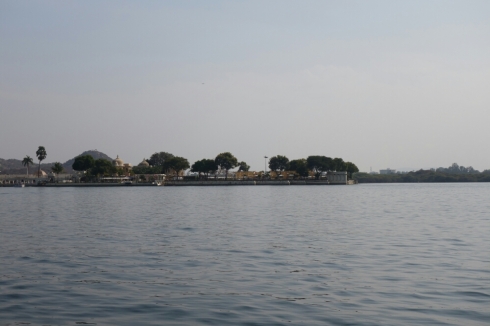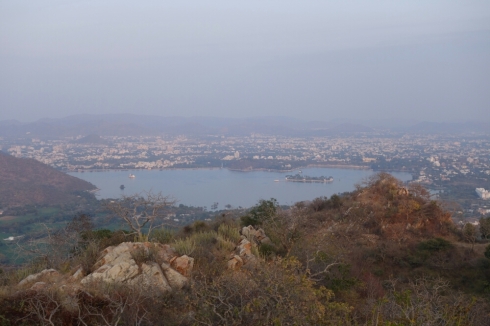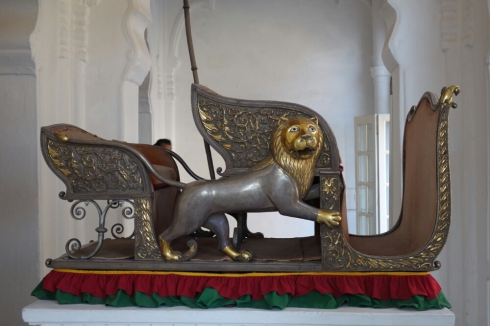Right so I finally got to Varanasi. This hostel I actually booked in advance and the main reason for booking was that they organise tours. As luck would have it the hostel turned out to be REALLY nice. Clean rooms, plug points next to all beds, really nice communal chill out areas, nice hot shower and fast internet for the first time in AGES. As they say in Hindi, “Aur kya chahiye”.
So on arriving at the Hostel at around 8:45am I saw there was a temple tour leaving at 10am, so signed up to that. Our guide was Anil and I learnt a lot about hindism.
Before starting the tour we went to where they clean clothes:

So they have a series of pipes that delivers purified water from the river to this area and when the water is very dirty, it drains back into the river and they fill this area with clean water again. The people here work from generation to generation, literally beating the dirt out of clothes and the government are recognising this as an official place to wash clothes and are currenty in the process of building concrete slabs to wash clothes on.
Varanasi is one of the oldest living cities in the world and probably derives from the two rivers that flank the city, the Varuna to the north and the Asi to the south.
So moving onto the teple tour, there are three main gods, Brahma (creator), Vishnu (protector) & Shiva (the destroyer of evil). Brahma’s wife is called Saraswati, Vishnu’s wife is called Laxmi and Shiva’s wife is called Parvati. Majority of the temples in Varanasi are dedicated to Lord Shiva and therefore Varanasi is often referred to as Lord Shiva’s City. Varanasi’s associations with Shiva extend to the beginning of time: legends relate how, after his marriage to Parvati, Shiva left his Himalyan abode and came to reside in Kashi (another name for Varanasi). Shiva has had many avatars on earth including Hanuman (monkey god) and Vishnu had 10 avatars in total with the most recent being number 9 in the form of Buddha. The final avatar is called Kalki and is due any time now.
So the first temple we went to was a Durga mandir. Durga is an avatar of Parvati. It is said that goddess Durga protects her devotees from the evils of the world and at the same time removes their miseries. Therefore people pray for that purpose.
In a lot of these temples – you can’t take pictures inside the mandir which is quite irritating but this is what it looked like from a distance.

Within the temple I saw lots of priests chanting and a HUGE havan. There was a main Durga statue that everyone was praying to and at the end of praying everyone walks once clockwise round the temple.
After this we went to a temple where some guy had translated the Gita from sanskrit to hindi and all the walls were filled with the translation. It wasn’t really that interesting:


After this we went to Sankat Mochan Hanuman Temple. Unforunately there was a bombing there some time back so security was very tight and no phones or cameras were allowed in so have no pictures. As you go in there are loads of monkeys and eventually you get to the main mandir which has a statue of Hanuman and right opposite there is a temple dedicated to Rama & Sita. Rama was an avatar of Vishnu and within the Ramayana there is a story of Hanuman (Lord Shiva) praying to Rama. This would seem a bit odd, why would one god pray to another but the reason was to show that anyone, be it god or human can pray. This is why they have a statue of Hanuman which is facing another mandir of Rama and Sita.
That was the end of the tour. In the evening they had a food tour where the guide took us to all local places to eat. The food was amazing. So we first started out at a chaat place:


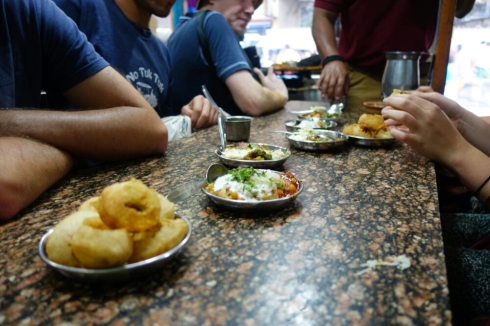
Was really nice and came to 20 rupees (20p). After this we went to the Muslim part of town for some meat. They also had the cheapest Naan in Varanasi at 4 rupees a naan. So I had a naan and a chicken roll for 50 rupees:

Check out old town:


It was EXTREMELY dirty and smelly. Congested with cows everywhere and stinks of cow crap and other waste.
After this we went to the famous Blue Lassi shop in Varanasi where he had pages and pages of varieties of Lassi:


I had a Kesar Pista one. Was nice.
After this we proceeded to Mithai:

Lastly had paan:
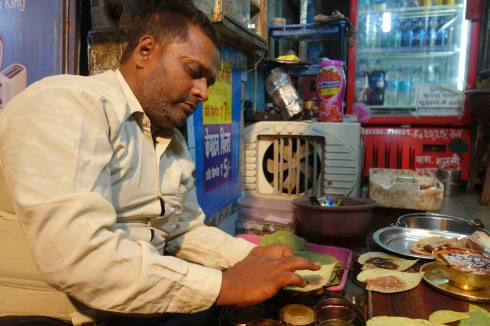
A very nice meal and all within 100 rupees so £1.
The next day I did a Market tour in the morning which was interesting. We started off in a paan market. It was cray to see. It was a wholesale paan market and the paan leaves all vary in price massively. Apparently there is this one leaf that seasonal and out of season it sells at a crazy premium:



So they sell these paan leaves wholesale in these baskets. They also sell them at varying levels of ripeness. It was interesting to see.
Check this guy out making fresh Sev:

After this we went to the spice market:

Followed by the iron market:

And then stopped for tea here which was really nice:

Lastly we went to the flower market which was a sight:

It was good in that we got to see a lot of the very non touristy part of Varanasi.
In the evening I went to do a ghat tour followed by the famous arti. In this learnt all about the cremation process. So this is the famous holy river:





We then got on a boat and did a river tour of the ghats:

So the ghats are quite literally just the stairs leading down to the holy river. The city has nearly 100 ghats. Most of the ghats are bathing and puja ceremony ghats, while a few are used exclusively as cremation sites.

Dashashwamedh Ghat is located close to Vishwanath Temple, and is probably the most spectacular ghat. Two Hindu mythologies are associated with it: According to one, Lord Brahma created it to welcome Lord Shiva. According to another, Lord Brahma sacrificed ten horses in a yajna here.


After this we went to one of the ghats used exclusively for cremating bodies. Obviously no pictures were allowed out of respect but the guide explained the whole ceremony to us.
Now walking around the streets here you see a lot of dead bodies being carried on the street on a bamboo stretcher fully covered while they are chanting “Rama nama satya hai” meaning “God’s name is truth”.
What is interesting is that not everyone is cremated. Holy men, lepers and people with small pox have traditionally been buried, with holy men traditionally buried in a vertical position preserved with salt. Small children under two are not cremated because their soul does not need purifying. In many cases today they are not buried but are taken to the middle of the Ganges or another sacred river and dropped to the river bottom with a weighed stone. Families who can not afford the wood for cremation sometimes throw unburned corpses in the Ganges. In some cases an effigy is burned to symbolize cremation. Few people are buried. These are victims of suicide, murder, or some other kind of violence who, it is believed, have souls that will not rest, no matter what is done to the corpse.
Bodies are usually cremated within 24 hours after death, if at all possible, even if close relatives can not attend the funeral. Ideally cremation is done within 12 hours after death, or at the very latest before sundown on the next day if death occurs late in the afternoon. There is little mourning when a Hindu dies because they believe that once a person is born he or she never dies. Often there is little crying. Some Indians have said this is because the point of a funeral is to show respect not sadness. Traditionally women have not been allowed at cremations because they might cry. Their tears like all bodily fluids are regard as pollutants and will mean the soul will not find peace. Women are not supposed to enter the cremation area or even watch what goes on inside it. This includes close relatives and family members. They may help lay out the body at home but carrying the body, gathering the wood and lighting the fire are all considered man’s work.
Varanasi (Banaras, or Benares) is the place every Hindu hopes to be when he or she dies so they can escape the cycle of rebirth and death. If a person dies in the Ganges or has Ganges water sprinkled on them as they breath their last breath it is believed they achieve absolute salvation, escaping the toil of reincarnation to be transported to Shiva’s Himalayan version of heaven. Therefore every Hindu wants to die in Varanasi. Cremations have been taking place in the Ganges for thousands of years. Perhaps a 100,000 cremated bodies are thrown in the Ganges every year. In Varanasi, funeral parties wait for their turns on the steps of the ghats. There is even a caste that specializes in sifting through the ashes and mud at the bottom of Ganges for rings and jewelry.
Once dead the family members have traditionally prepared the body of the deceased. Before cremation, the body is wrapped and washed, with jewelry and sacred objects intact, in a plain sheet. A red cloth is used for holy people. Married women are buried in their wedding dress and an orange shroud. Men and widows have a white shroud. Later the body is dressed in fine clothes and the nail are trimmed and thumbs are tied together while scriptures are read. Often some leaves of the Tulasi tree and few drops of sacred water are placed in the mouth of the deceased. In ancient times the funeral bed was made from rare wood and antelope skin. These days it is made from bamboo or common kinds of wood and no animal skins are used. After the body has been prepared it is carried by male relatives on a flower-draped bamboo bier to the cremation ghats. There is no coffin. Male relatives that carry the shrouded body chant “Rama nama satya hai,”. The eldest son is in the lead. He has been purified in a special ritual and carries a fire kindled in the home of the deceased. The fire is carried in a black earthen pot. The body is immersed in the river before being placed on the funeral pyre.
The body is anointed with ghee (clarified butter). Men are sometimes cremated face up while women are cremated face down. The funeral pyre is often made of corkwood and offerings of camphor, sandalwood and mango leaves. Sandalwood also masks the smell of the burning body very well. The ghee ensures the body burns evenly. A typical pyre is made of 300 kilograms or so of wood. Rich families sometimes pay for the entire pyre to be made up of sandalwood. Mantras are recited to purify the cremation grounds and scare away ghosts. Offerings are made to Agni, the fire god, at an altar.
It was all very interesting to see. Also depending on what cast you are – you have different ghats you can be cremated at.
Anyway after seeing all that we went to the famous Aarti. A group of priests daily perform “Agni Pooja” (Worship to Fire) wherein a dedication is made to Lord Shiva, River Ganges, Surya (Sun), Agni (Fire), and the whole universe. Was again very intersting to see:

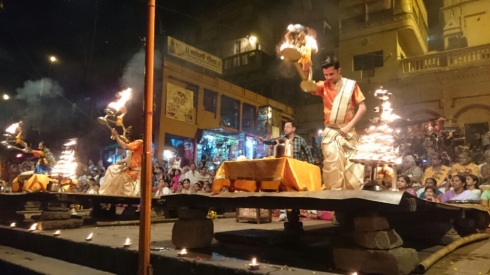

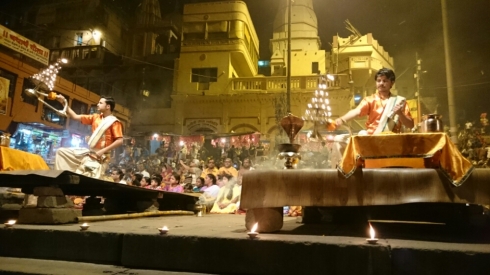

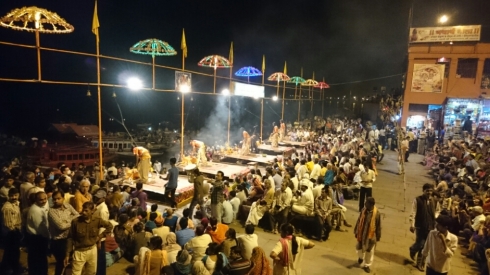
The next day someone from my hostel was going to a place called Sarnath where Buddha gave his first sermon. The Auto ride there was INSANE. Traffic over here is on another level. At one point we got to a railways crossing and the barriers came down and people leant their bikes over and got under the barrier and crossed. On top of that people on both sides of the crossing were waiting on both sides of the road such that when the barriers did eventually come up, it was pure chaos. Anyway finally made it to the place. The place where he gave the first sermon, King Ashok had built a huge Stupa.
We started off with visiting the buddist temple that was built on the grounds:



The inside:

They also had a memorial statue of Budda and his five students:


The buddist good luck spinning wheels:

After this we went to see the stupa. It was in a beautiful ground and is said walking around it gives you luck. Buddists from all over asia come to see it.




We walked round it about three times just to make sure we went fully round it! The grounds were beautiful:




What was interesting is that the tree that Buddha found enlightenment under was in Bodh Gaya around 250km from Varanasi but they took cuttings from the tree and planted one at Sarnath and one somewhere in Sri Lanka. This was the one at Sarnath.

It was very nice to see a place so tranquil and quiet in Varanasi. The rest of Varanasi is just pure crazy. Was also interesting to learn a bit about Buddha.
The next day I went back to the Ghats and walked around. I went to the main ghat where they cremate the bodies and saw it all close up. So after carring the body through the streets, they dip the body in the river and then put it on the pyre. They then add more bits of wood on the body and have this huge bit of hay with a coal piece on it. Then they walk round the body touching the fire to the head every time and then finally burn the body. After a while the fire burnt through the clothes and you see the skull and bones – was a pretty horrific sight but interesting to see.
The next day I went to the main temple in Varanasi. It’s called Kashi Vishwanat. I’ve never seen so much security around a temple. It’s CRAZY. There was obviously no cameras or even mobile phones anyway near the temple. There were like multiple check points to get to the mandir and LOADS of police all around. There were a lot of police although am not sure that necessarily translates into good security. The temple itself wasn’t anything great. Lots of small temples dedicated to Lord Shiva.
I liked that Chaat place so much from the food tour I went back everyday. The whole menu is in Hindi on the board and I asked him for an English menu of which there is none. I basically let him recommend dishes for me and would just eat them, after every dish I would ask what’s next and something amazing would be presented. That place is REDICULOUSLY cheap and I have on average three chaat dishes, a coke and a Kulfi for £1.50. I always have plans to go to the Muslim part of town and get some meat but am always full after the chaat. I could easily be vegetarian here. Favourites were Papdi Chat, Dahi Puri & Dai Vada.
I have also been going to the Aarti ceremony daily. The atmosphere is really nice which is the only real reason I go.
So it’s the end of my time in Varanasi. Varanasi has been CRAZY. It’s the dirtiest place I have been to, cows all over the place, craziest traffic I have seen in india, plublic urination seems to be the norm and I’m sure people spit a lot more here than other parts of India. However it’s definately an interesting place with the spritual and religious signifance very apparent everywhere you look. Anywy tomorrow am off to Gujarat to see Ba! Can’t wait.

